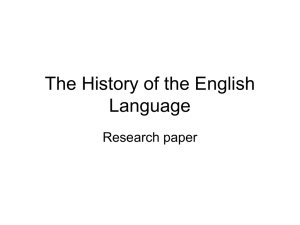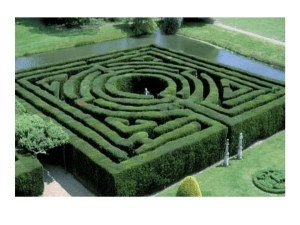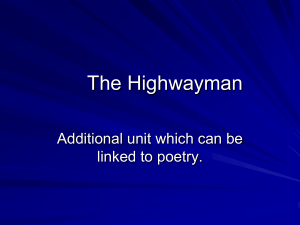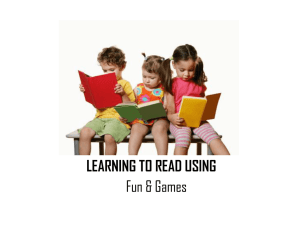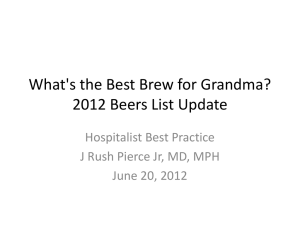Reading Strategies
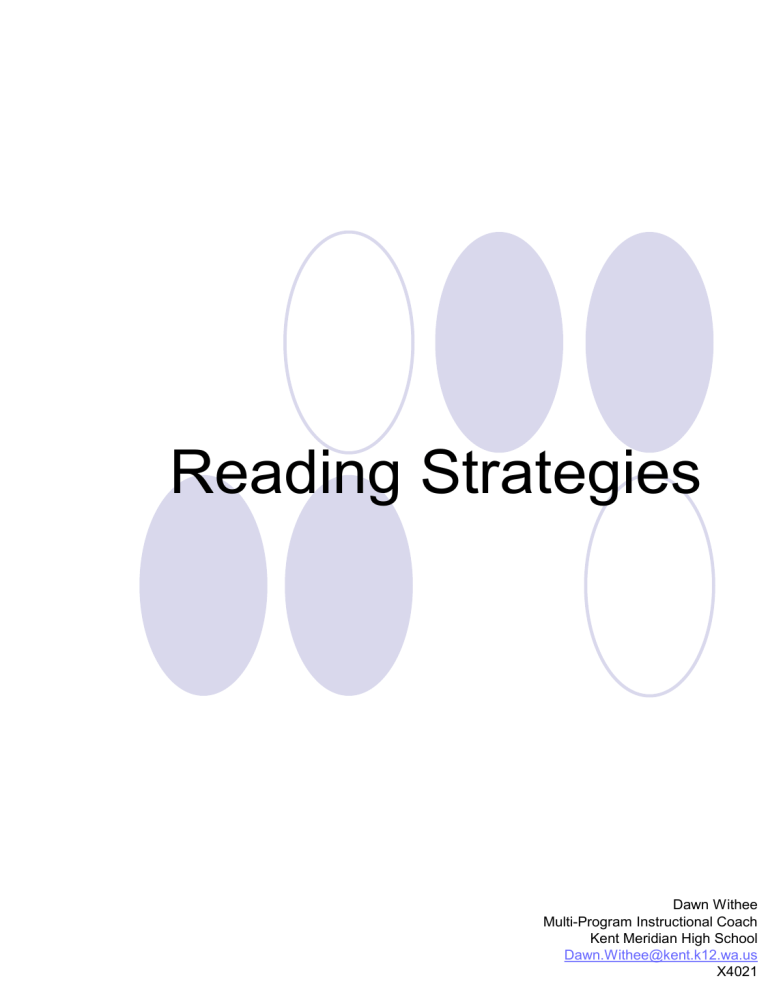
Reading Strategies
Dawn Withee
Multi-Program Instructional Coach
Kent Meridian High School
Dawn.Withee@kent.k12.wa.us
X4021
Cognitive Strategies
Predict
Make connections
Visualize
Ask questions
Summarize
Make inferences
Use context clues
Monitor and adjust reading speed
Monitor and clarify for understanding
Before Reading
Good Readers
Access their prior knowledge
Interact with portions of text
Practice sequencing, find cause & effect relationships, draw comparisons, make inferences, and predict
Identify vocabulary that might be a problem
Construct meaning before the begin reading the text
Kylene Beers
During Reading
Good Readers
Predict what will happen next
Question what they don’t understand or what is confusing in the text
Monitor their understanding of the text
Identify ways to fix up what has confused them in the text
Clarify what has confused them
Comment on the text or their understanding of the text
Connect what they are reading to other texts or personal experiences
Visualize the text
Kylene Beers
After Reading
Good Readers:
Question what they don’t understand or what is confusing in the text
Monitor their understanding of the text
Identify ways to fix up what has confused them in the text
Clarify what has confused them
Comment on the text or their understanding of the text
Connect what they are reading to other texts or personal experiences
Visualize the text
Compare or contrast one part of the text to another
Summarize what they have read
Identify main characters, major events, and details
Identify conflicts or main problems in the text
See causal connections in a text
Make inferences and draw conclusions
Distinguish between fact and opinion
Kylene Beers
Making Connections
Activating Prior Knowledge
Building Prior Knowledge
Integrating curriculum/concepts
Types of connections
Text-to-self
Text-to-world
Text-to-text
Cause-Effect
Chronological
Comparison/Contrast
Use prior knowledge to make predictions and inferences
KWL
What I
KNOW
What I
WANT to
Know
What I
LEARNED
KWL Example —Heat
What I
KNOW
Things melt when hot
Things turn from solid to liquid to gas because of heat
Mercury expands with heat — thermometer
Water boils at
212 °F
Depends on altitude
Everything has a boiling point
Fire causes heat
What I
WANT to
Know
What makes heat?
If everyone in
America turned on a blow dryer at the same time, would it heat up the atmosphere?
What is the boiling point at our school?
Why do different things require different amounts of heat to melt them?
What I
LEARNED
Text Impression
A Pre, during or after reading activity that arouses curiosity and allows students to anticipate what the reading might be about, to focus on the key words and concepts while reading, an to connect that information through writing after reading.
Can be used with both narrative and expository text.
Uses clue words as a basis for predicting content, focusing during reading, and connecting information after reading.
Procedure:
Teacher selects clue words from the reading — between five and seven. This causes the teacher to decide what is most important to learn.
Teacher sequences them with arrows to form a descriptive chain.
Before reading, students write a paragraph based on the chain of words. This gives students an opportunity to connect prior knowledge to new learning that will occur.
While reading, students should focus on the words
(concepts while reading). This creates an awareness on the students’ parts of important concepts to be learned.
After reading, students write a paragraph
(somewhat of a summary) using as many of the clue words as possible and any other important words found in the text. LOOK BACKS in the text should be encouraged while writing.
Mary Spor
Text Impressions Example
Ingenious
Patriot
Invincible
Extortion
Loyalty
Peculiar
Scrutiny
The Ingenious Patriot
Ambrose Bierce
Having obtained an audience of the King an Ingenious Patriot pulled a paper from his pocket, saying:
"May it please your Majesty, I have here a formula for constructing armour-plating which no gun can pierce. If these plates are adopted in the Royal Navy our warships will be invulnerable, and therefore invincible. Here, also, are reports of your Majesty's Ministers, attesting the value of the invention. I will part with my right in it for a million tumtums."
After examining the papers, the King put them away and promised him an order on the Lord High Treasurer of the
Extortion Department for a million tumtums.
"And here," said the Ingenious Patriot, pulling another paper from another pocket, "are the working plans of a gun that I have invented, which will pierce that armour. Your Majesty's Royal
Brother, the Emperor of Bang, is anxious to purchase it, but loyalty to your Majesty's throne and person constrains me to offer it first to your Majesty. The price is one million tumtums."
Having received the promise of another check, he thrust his hand into still another pocket, remarking:
"The price of the irresistible gun would have been much greater, your Majesty, but for the fact that its missiles can be so effectively averted by my peculiar method of treating the armour plates with a new -"
The King signed to the Great Head Factotum to approach.
"Search this man," he said, "and report how many pockets he has."
"Forty-three, Sire," said the Great Head Factotum, completing the scrutiny.
"May it please your Majesty," cried the Ingenious Patriot, in terror, "one of them contains tobacco."
"Hold him up by the ankles and shake him," said the King;
"then give him a check for forty-two million tumtums and put him to death. Let a decree issue declaring ingenuity a capital offence." http://www.eastoftheweb.com/short-stories/UBooks/IngPat.shtml
Preview and Predict
Preview and Predict is a comprehension strategy that causes the reader to activate prior knowledge by using clues about the content.
Procedures:
Preview the text in a short period of time (3-5 minutes) by viewing and discussing various aspects of the text such as:
Narrative Text:
Title
Title Page
Front and back cover
Author & Illustrator information
Pictures
Chapter Titles (and layout)
Opening Paragraph
Prologue, forward, afterward, epilogue
Any other unusual features
Expository Text
Table of contents
Index
Chapter titles
Headings & subheadings
Captions
Charts, graphs, tables
Typographic features
Glossary, appendices, index
Any other unusual features
Encourage students to predict what the text may be about. When working with the whole class, the teacher can write the students’ predictions on an overhead transparency or on the chalk/white board.
Students should be able to justify how aspects of the preview supported their predictions.
Students then read a portion of the text, stopping at critical points to discuss whether their predictions were or were not confirmed by the text or story. If predictions were supported by the text, students make new predictions and read on. If predictions were not supported by the text, the predictions should be modified or changed to reflect the text.
When using chapter books or expository texts, the preview may also include summarizing previous chapters. The first paragraph may be read for additional clues about what will happen next.
Mary Spor
Anticipation Guide
Teacher writes a few (2-10) generalizations that relate to the main ideas or themes of the text. Choose statements that are controversial, or that might be commonly held, but will be challenged by the text.
Before reading, students mark agree or disagree for each statement.
As a class discuss the statements and students’ responses.
Read Text. Students may want to take notes on the anticipation guide when they get to parts of the text relevant to each statement.
After reading, students mark agree or disagree on the guides a second time.
In a class discussion, and/or in writing, students explore how their opinion changed based on what they read.
You might also have students revisit the guide answer as a particular character, historical figure, etc.
Kylene Beers and Mary Spor
Anticipation Guide -
Example
Before Reading
Agree Disagree
1. True love can overcome any hardship or affliction.
After Reading
Agree Disagree
2. The more beautiful a woman is, the more she is worthy of true love.
3. Women in power are morally corrupt.
Have You Ever…
Similar to an anticipation guide
Generate a list of experiences that are relevant to the text
Have students mark a check by anything they have done
Possible activities for processing the list
As a class go through the list and make tally marks to see collective class experience
Have students share anecdotes about their experiences
Have students pick 1 to 3 experiences to write about
After reading
Have students write, comparing their experience to the text
Have students pretend they are a character from the text and check the expereicnes accordingly. Then have them reflect on how the character’s experiences compare to their own.
Have You Ever… - example
Life of Penguins
Have you ever…
__ Been in a life and death situation?
__ Had to hunt for food?
__ Gone swimming in freezing water?
__ Eaten raw fish?
Probable Passage
A brief summary of the text, with key words omitted.
Keys words presented separately in a list
Defined
Classified as to their function within the text
Students write the words in the blanks, predicting how they will fit into the text
Students read text
Students look back at the probable passage to see how their prediction matched up with the text
Teachers should emphasize making valid predictions, and de-emphasize being
“right.”
Kylene Beers
Probable Passage - Example
Vocabulary
Australia
Crust
Icebergs
Islands
Ocean
Poles
Water
What Where
Passage:
_____ are giant formations of frozen _____. The form at the earth’s _____. They are different from _____ because they float on top of the _____, and are not connected to earth’s _____. They can be as big as
_____.
Tea Party
Teacher writes sentences, phrases, and/or words (directly quoted from text) on note cards.
1 note card per student
Repeat phrases 2-3 times (1/2 as many phrases as students is a good rule of thumb)
Students move around the house sharing and discussing their phrases (they should activate prior knowledge and make predictions)
Students form small groups and discuss what they think the text will be about
Groups write a paragraph beginning with
“We think this selection is about…”
As a class, groups share and explain their ”we think” statements.
Read the selection
Kylene Beers
Say Something
Students take turns reading in groups of 2-3
Students occasionally pause reading to say something
Make a prediction
Ask a questions
Make a connection
Comment on what is happening in the text
Clarify a confusion
Group members comment on what student said
Another student continues reading
Kylene Beers
Think Aloud
A Think Aloud* is a comprehension monitoring strategy that helps the teacher and the reader to recognize the text-based and schema-based strategies he/she uses while reading text aloud.
This can serve as an intervention tool or an expansion of reading power activity. For a Think Aloud to be successful, the teacher and the students must be cognizant of effective reading strategies, the role of schema in comprehension, and the structure and content of the text being read.
Text-based strategies include connections with previous reading, pointing out main ideas, translating information into one’s own words, pointing out lack of understanding, using strategies to make sense out of text not understood, recognizing the internal structure of text (sequence, cause/effect, comparison/contrast, description, problem/solution).
Schema (according to cognitive Psychology) is an organized network of concepts, experiences, and data. Schema-based strategies include making connections to prior knowledge (life experience, previous reading and learning, prediction, elaboration, inference).
Procedures:
Choose both easy and difficult text to read aloud.
Model how to use a Think Aloud.
Provide students with an easy and difficult text.
Ask students to read aloud and note in the margins (or if working individually with a teacher or partner, tell orally) what they are thinking as they read the text.
Compare and contrast the strategies used with easy and difficult text.
Are they schema-based, text-based, or a combination of both?
What additional strategies could this student use to build comprehension of this particular text.
Mary Spor
It says, I say and So
Question It Says
Read the
Questions
Find
Information from the text that will help you answer the question
I Say
Think about what you know about that information
And So
Combine what the text says with what you know to come up with the answer
Kylene Beers
Question
Why did he
Wicked
Witch hate
Sleeping
Beauty?
It Says I Say And So
The Mirror said
Sleeping
Beauty was the fairest in the land
Women can get really jealous of one another, especially when looks are involved.
The witches jealousy drove her to homicidal rage.
Graphic Organizers
Make Graphic Organizers
Using:
Inspiration
PowerPoint
Word
Publisher
Web Sites such as ReadingQuest
Sociograms
Have students create a visual charting relationships between people (or countries, animals, concepts, etc.)
Use shape/color to represent different people
Use lines and distance to represent the relationships between people
Double Bubble Map
Venn Diagram
Chronological Map
T Chart
Cycle of Events
EVENT EVENT
EVENT EVENT
EVENT
H Chart
Cause-Effect
Cause-Event-Effect
Cause Cause Cause Cause
Event
Effect Effect Effect Effect
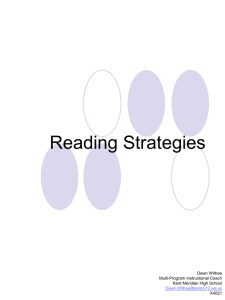

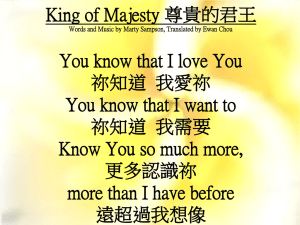

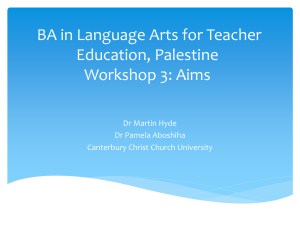
![SEM_1_-_2.03-2.04_and_2.06_PPT[1]](http://s2.studylib.net/store/data/005412429_2-ee09ccc3ae8bb5a8455b0fdbcc5543ae-300x300.png)
